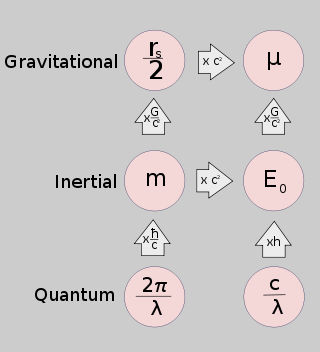Standard gravitational parameter
| Body | μ (m3 s−2) |
|---|---|
| Sun | 1.32712440018(9)×1020[1] |
| Mercury | 2.2032(9)×1013 |
| Venus | 3.24859(9)×1014 |
| Earth | 3.986004418(9)×1014 |
| Moon | 4.9048695(9)×1012 |
| Mars | 4.282837(2)×1013[2] |
| Ceres | 6.26325×1010[3][4][5] |
| Jupiter | 1.26686534(9)×1017 |
| Saturn | 3.7931187(9)×1016 |
| Uranus | 5.793939(9)×1015[6] |
| Neptune | 6.836529(9)×1015 |
| Pluto | 8.71(9)×1011[7] |
| Eris | 1.108(9)×1012[8] |
In celestial mechanics, the standard gravitational parameter μ of a celestial body is the product of the gravitational constant G and the mass M of the body.
For several objects in the Solar System, the value of μ is known to greater accuracy than either G or M.[9] The SI units of the standard gravitational parameter are m3 s−2.
Small body orbiting a central body

The central body in an orbital system can be defined as the one whose mass (M) is much larger than the mass of the orbiting body (m), or M ≫ m. This approximation is standard for planets orbiting the Sun or most moons and greatly simplifies equations. Under Newton's law of universal gravitation, if the distance between the bodies is r, the force exerted on the smaller body is:
Thus only the product of G and M is needed to predict the motion of the smaller body. Conversely, measurements of the smaller body's orbit only provide information on the product, μ, not G and M separately. The gravitational constant, G, is difficult to measure with high accuracy,[10] while orbits, at least in the solar system, can be measured with great precision and used to determine μ with similar precision.
For a circular orbit around a central body:
where r is the orbit radius, v is the orbital speed, ω is the angular speed, and T is the orbital period.
This can be generalized for elliptic orbits:
where a is the semi-major axis, which is Kepler's third law.
For parabolic trajectories rv2 is constant and equal to 2μ. For elliptic and hyperbolic orbits μ = 2a| ε |, where ε is the specific orbital energy.
Two bodies orbiting each other
In the more general case where the bodies need not be a large one and a small one (the two-body problem), we define:
- the vector r is the position of one body relative to the other
- r, v, and in the case of an elliptic orbit, the semi-major axis a, are defined accordingly (hence r is the distance)
- μ = Gm1 + Gm2 = μ1 + μ2, where m1 and m2 are the masses of the two bodies.
Then:
- for circular orbits, rv2 = r3ω2 = 4π2r3/T2 = μ
- for elliptic orbits, 4π2a3/T2 = μ (with a expressed in AU; T in seconds and M the total mass relative to that of the Sun, we get a3/T2 = M)
- for parabolic trajectories, rv2 is constant and equal to 2μ
- for elliptic and hyperbolic orbits, μ is twice the semi-major axis times the absolute value of the specific orbital energy, where the latter is defined as the total energy of the system divided by the reduced mass.
Terminology and accuracy
The value for the Earth is called the geocentric gravitational constant and equals 398600.4418±0.0008 km3 s−2. The uncertainty is just 1 to 500000000 because this quantity is derived from the movement of artificial satellites, which basically involves observations of the distances from the satellite to earth stations at different times, which can be obtained to high accuracy using radar or laser ranging.
However, the M (mass of the Earth in kilograms) can be found out only by dividing the MG by G, and the G is known only by laboratory measures of the attraction between two known masses. The uncertainty of those measures is 1 to 7000, so M will have the same uncertainty.
The value for the Sun is called the heliocentric gravitational constant or geopotential of the Sun and equals 1.32712440018×1020 m3 s−2. The uncertainty in the HGC is smaller than the uncertainty in the GGC because the HGC is derived from the ranging of interplanetary probes, and the absolute error of the distance measures to them is about the same as the earth satellite ranging measures, while the absolute distances involved are much bigger.
Note that the reduced mass is also denoted by μ.
See also
References
- ↑ "Astrodynamic Constants". NASA/JPL. 27 February 2009. Retrieved 27 July 2009.
- ↑ "Mars Gravity Model 2011 (MGM2011)". Western Australian Geodesy Group.
- ↑ "Asteroid Ceres P_constants (PcK) SPICE kernel file". Retrieved 5 November 2015.
- ↑ E.V. Pitjeva (2005). "High-Precision Ephemerides of Planets — EPM and Determination of Some Astronomical Constants" (PDF). Solar System Research. 39 (3): 176. Bibcode:2005SoSyR..39..176P. doi:10.1007/s11208-005-0033-2.
- ↑ D. T. Britt; D. Yeomans; K. Housen; G. Consolmagno (2002). "Asteroid density, porosity, and structure" (PDF). In W. Bottke; A. Cellino; P. Paolicchi; R.P. Binzel. Asteroids III. University of Arizona Press. p. 488.
- ↑ R.A. Jacobson; J.K. Campbell; A.H. Taylor; S.P. Synnott (1992). "The masses of Uranus and its major satellites from Voyager tracking data and Earth-based Uranian satellite data". Astronomical Journal. 103 (6): 2068–2078. Bibcode:1992AJ....103.2068J. doi:10.1086/116211.
- ↑ M.W. Buie; W.M. Grundy; E.F. Young; L.A. Young; et al. (2006). "Orbits and photometry of Pluto's satellites: Charon, S/2005 P1, and S/2005 P2". Astronomical Journal. 132: 290. arXiv:astro-ph/0512491
 . Bibcode:2006AJ....132..290B. doi:10.1086/504422.
. Bibcode:2006AJ....132..290B. doi:10.1086/504422.
- ↑ M.E. Brown; E.L. Schaller (2007). "The Mass of Dwarf Planet Eris". Science. 316 (5831): 1586. Bibcode:2007Sci...316.1585B. doi:10.1126/science.1139415. PMID 17569855.
- ↑ This is mostly because μ can be measured by observational astronomy alone, as it has been for centuries. Decoupling it into G and M must be done by measuring the force of gravity in sensitive laboratory conditions, as first done in the Cavendish experiment.
- ↑ George T. Gillies (1997), "The Newtonian gravitational constant: recent measurements and related studies", Reports on Progress in Physics, 60 (2): 151–225, Bibcode:1997RPPh...60..151G, doi:10.1088/0034-4885/60/2/001. A lengthy, detailed review.